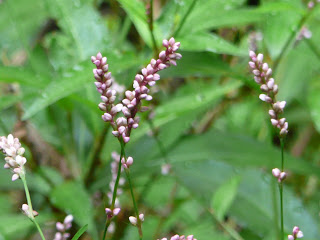Six years after moving to North Carolina, I had the opportunity to go to Asheville for my day job. Driving west along I-40, the undulating hills of the Piedmont eventually lead into the Appalachians; when you hit exit 94, the ridges spill out endlessly towards the horizon and it still takes my breath away every time.
 The day of my return to the Triangle, I had a few hours to spare in the morning. The Blue Ridge Parkway was but a handful of blocks from my hotel, so I stopped by the Visitor's Center and took a run through the trail loop. The views from here were nowhere near as spectacular as I would later discover elsewhere along the Parkway, but I found myself more captivated by the flora rather than the surrounding landscapes.
The day of my return to the Triangle, I had a few hours to spare in the morning. The Blue Ridge Parkway was but a handful of blocks from my hotel, so I stopped by the Visitor's Center and took a run through the trail loop. The views from here were nowhere near as spectacular as I would later discover elsewhere along the Parkway, but I found myself more captivated by the flora rather than the surrounding landscapes.
It was early fall and the air was beginning to become more crisp. The broadleaf plants of the lower elevations were fewer in population, giving way to smaller flowers and evergreens.
 I walked along the path, stumbling upon patches of mountain daisies, oak vines winding their way along the edge of the trail, and a squirrel that startled me just as much as I startled him.
I walked along the path, stumbling upon patches of mountain daisies, oak vines winding their way along the edge of the trail, and a squirrel that startled me just as much as I startled him.About two-thirds of the way down the trail, I by chance looked to my left to find a large, yet delicate spiderweb glistening in the light filtering through the trees. Its architect had wandered elsewhere, leaving behind her handiwork.
Despite the surrounding peaks and valleys, on that morning, it was this that held my attention:

















































